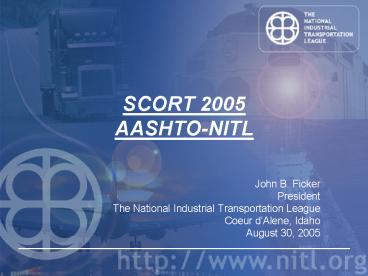SCORT 2005 AASHTONITL - PowerPoint PPT Presentation
1 / 14
Title:
SCORT 2005 AASHTONITL
Description:
A shipper can be any entity that is engaged in the movement of freight, whether ... the country and connects it to the world cannot be built on a parochial basis. ... – PowerPoint PPT presentation
Number of Views:65
Avg rating:3.0/5.0
Title: SCORT 2005 AASHTONITL
1
SCORT 2005AASHTO-NITL
- John B. Ficker
- President
- The National Industrial Transportation League
- Coeur dAlene, Idaho
- August 30, 2005
2
NITL
3
Today Who is a Shipper?
- Traditional Definition
- An entity that manufactured products for
delivery to customers or secondary manufacturing. - Five elements have changed this definition
- Deregulation of all modes of transportation
- The growth of intermodalism
- The growth of information technology
- Globalization
- Outsourcing
4
Todays Definition
- A shipper can be any entity that is engaged in
the movement of freight, whether manufacturer,
distributor, third party logistics provider or a
carrier using another mode as a means to
provide service to their customer.
5
What are Shippers needs
- A goal of a shipper is quite simple
- Turn product or service into cash!
- To achieve this goal there are three common
requirements - Capacity
- Performance
- Cost
- Shippers with different needs will prioritize
these differently.
6
What is the Shipper Perspective
- Economic growth in a consumer economy means
increased goods movement an opportunity for all
transportation providers - Shippers will always look to meet the demands of
their customers - Many demands are seasonal, i.e. holidays
- Shippers will utilize the transportation mode and
provider that allows them to meet their
customers needs - Will capacity keep up with demand?
- What will it take to meet this demand?
7
Observations
- Role of the shipper
- First AASHTO/NITL meeting
- League position on current rail issues
- S. 919
- Short Line Rail Tax Credit
- Public/Private Sector conflicting goals
- SAFETEA-LU freight outcome
- Good start
- Cant sit on our laurels
8
Observations
- Personal mobility vs Freight mobility
- Local Regional/National/International
- Modal cooperation and collaboration
- Trucks are not the enemy, rather partners
- Size and weight
- Create a Shipper Advisory Board SAB
- Interaction with carriers is important, but it is
shippers who actually put the freight in
commerce.
9
- A modern, efficient, seamless transportation
network that interweaves the country and connects
it to the world cannot be built on a parochial
basis. - Big, nationally important projects, with costs
and benefits that often span several states and
regions, will bring advantages to far-flung areas
and cannot be completed with only local dollars. - The federal transportation system is supposed to
provide greater benefits to all by spreading
costs equitably and broadly - an approach that
requires vision and leadership. - Mort Downey
- Former Deputy Secretary of Transportation
10
- Future trust-fund projections are not
encouraging and we must confront this issue
sooner, rather than later. - Currently, the trust fund is financed primarily
by the federal fuel tax. With the rise of
alternative fuels and greater fuel efficiency,
this is not cutting it anymore. - We are relying on a 20th century mechanism in a
21st century world - Rep Thomas Petri
- Vice-Chair House TI Committee
11
The Reality
- Freight is the circulatory system of our
economy. - Demands of consumers will continue to grow
- Current capacity will not meet even the most
conservative growth estimates - This is a global challenge
- These are not short term problems!
12
The Need
- A Freight Transportation Policy at the Global,
National, State and Local level that - Recognizes the inherent value of each mode of
transportation - Provides incentives to all modes to improve
efficiencies and productivity - Encourages not only competition between and
within modes, but cooperation to take advantage
of inherent advantages of each mode. - Is inclusive of all stake holders, public sector,
labor, etc.
13
If it was up to me
- Leadership
- National Freight Transportation Policy
- Understanding by the public of the importance of
freight movement to their lives - Incentives for modal optimization and usage
- Technology
- Productivity
- Environmental
- Expedited processes for project development,
approval and implementation - Growing Transportation workforce
14
Summary
- Meeting our growing transportation needs demands
collaboration between all parties - Transportation Users (Shippers)
- Government federal/state/local
- Transportation Providers (Carriers) all modes
- Labor
- Third parties































